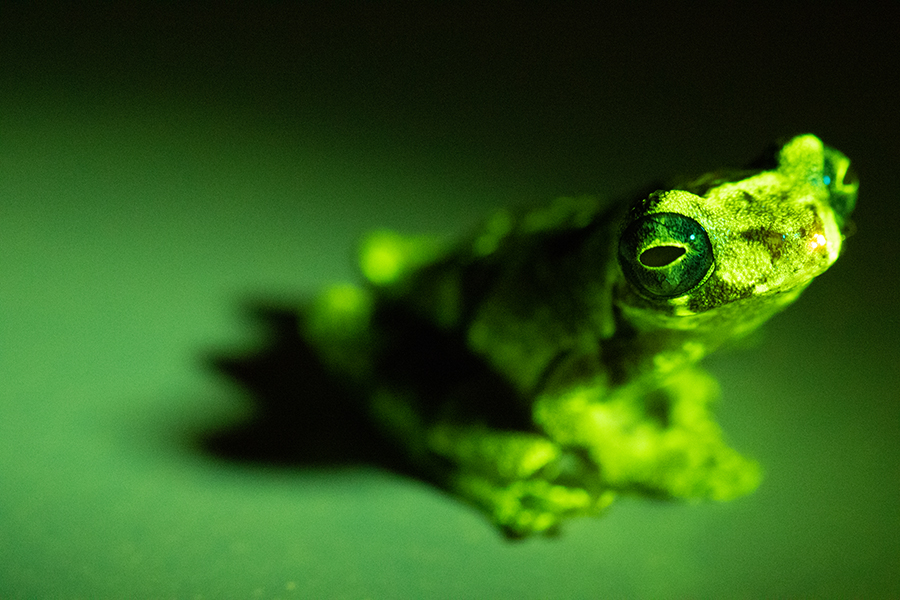A Light in the Dark
Doctoral candidate Courtney Whitcher is illuminating a new field of biological research

"Which aspects of life go unnoticed, escaping our view because they are too small, too quiet, or cloaked in a color we cannot see, thus disconnected from human senses? During a night-hike in the Costa Rican rain forest, on a high school Spanish trip, I was lured by secret signals hidden in the dark,” said Courtney Whitcher.
Since then, Whitcher, a doctoral candidate in the Florida State University Department of Biological Science, has worked to trace those signals and found a glowing world of biofluorescent organisms usually hidden from sight by the limits of human light and color perception.
A pioneer in her field of study, Whitcher works in the Moriarty Lemmon Lab to discover and describe biofluorescence that exists in the amphibian world.
Unlike bioluminescence, when an organism like a lightning bug or jellyfish emits light as a response to attract prey or defend itself from predators, biofluorescence occurs as a chemical or biological reaction inside an organism’s body. The result of that reaction makes biofluorescent animals radiate a steady light in a new color, like a glow stick.
“My research focuses on biofluorescent tree frogs and aims to discover how the trait has evolved within and influenced evolution of one of the world’s most diverse frog populations, from how these amphibians communicate to how they make mating decisions to how they survive predation,” Whitcher said.
Both human and frog eyes contain rods and cones that allow light to be converted into electrical signals we recognize as colors. However, a frog’s eyes contain an additional rod that allows them to see a broader range of colors imperceptible to the human eye in dim light.
Her work has wide implications, not only for researchers to gain understanding about the survival skills and reproductive aspects of frogs but to develop better approaches toward amphibian conservation efforts and environmental protections. The most exciting aspect, Whitcher says, is her research’s potential for human medical applications.
“The more we know about frog ecology and behavior, the better we can understand the environment we share with them,” she said. “Additionally, because fluorescent proteins are used to image and track biological processes at the molecular level, my work could allow for a more refined understanding of human molecular processes and advancement in medical research.”
Whitcher, a Michigan native, first became interested in frogs while working at the University of Michigan’s Museum of Zoology Amphibian and Reptile Division. She completed an undergraduate thesis on the Amazonian frog community and earned her bachelor’s degree in Ann Arbor. As the first biofluorescent frog was discovered in 2017, Whitcher was applying to graduate programs. That combined passion led her to pursue a doctorate in one of North America’s five richest biodiversity hotspots: the Florida Panhandle.
“Courtney boldly pushes forward not only on the frontiers of research but also on what is logistically and humanly possible,” said Emily Lemmon, FSU biology professor and head of the Moriarty Lemmon Lab. “I find this research exciting because just when we thought we had figured out how frogs communicate, we discover a secret conduit through which they have been sending and receiving information all along.”
On her Spring 2022 research trip to South America, Whitcher gathered primary data on 165 amphibian species that showcase signs of biofluorescence as a potential variable impacting mate choice and predation. This research is among the first of its kind — substantial developments in the study of biofluorescent phenomena only began in the early 1990s.
“Working with dedicated people like Courtney helps to create a supportive, dynamic and enthusiastic environment in the Lemmon Lab and the department,” Lemmon said.
Sharing her knowledge and expertise extends beyond Whitcher’s work in the lab. Since Fall 2019, she has stoked public curiosity and interest in biofluorescence via her Twitter account and website, sharing pictures from her own research excursions and amplifying work by fellow scientists. She has also introduced the local community to biofluorescence phenomena through the Tallahassee Museum’s Night Prowl events where she enjoyed watching community members ranging from ages four to 70 light up as they witnessed glowing changes in plants and other organisms.
“Science and discovery are great but most useful when you share that information with others. Humans innately want to learn, and seeing an organism glow in front of your own eyes is a great way to spark that curiosity,” Whitcher said. “Biofluorescence integrates biology, chemistry, and physics in fun, hands-on ways. It is a great avenue to get people interested in three crucial topics of science simultaneously by understanding the excitation of atoms and the biological processes that cause frogs to glow.”
Hannah Fulk is an FSU alumna who earned a bachelor’s degree in public relations in 2022. She is currently pursuing a master's degree in media and communications studies with a certification in digital video production and is set to graduate in May 2024.
Honorine Rouiller contributed to this story.
Glow for it
Ready to experience biofluorescence in your own backyard? All you need is a pair of filter glasses and a black light. In the same way that some frogs’ biology enables them to glow under black light, chlorophyll — the molecule that makes plants green and allows them to photosynthesize — also fluoresces. Shine a black light on a green plant and it will glow bright red!

